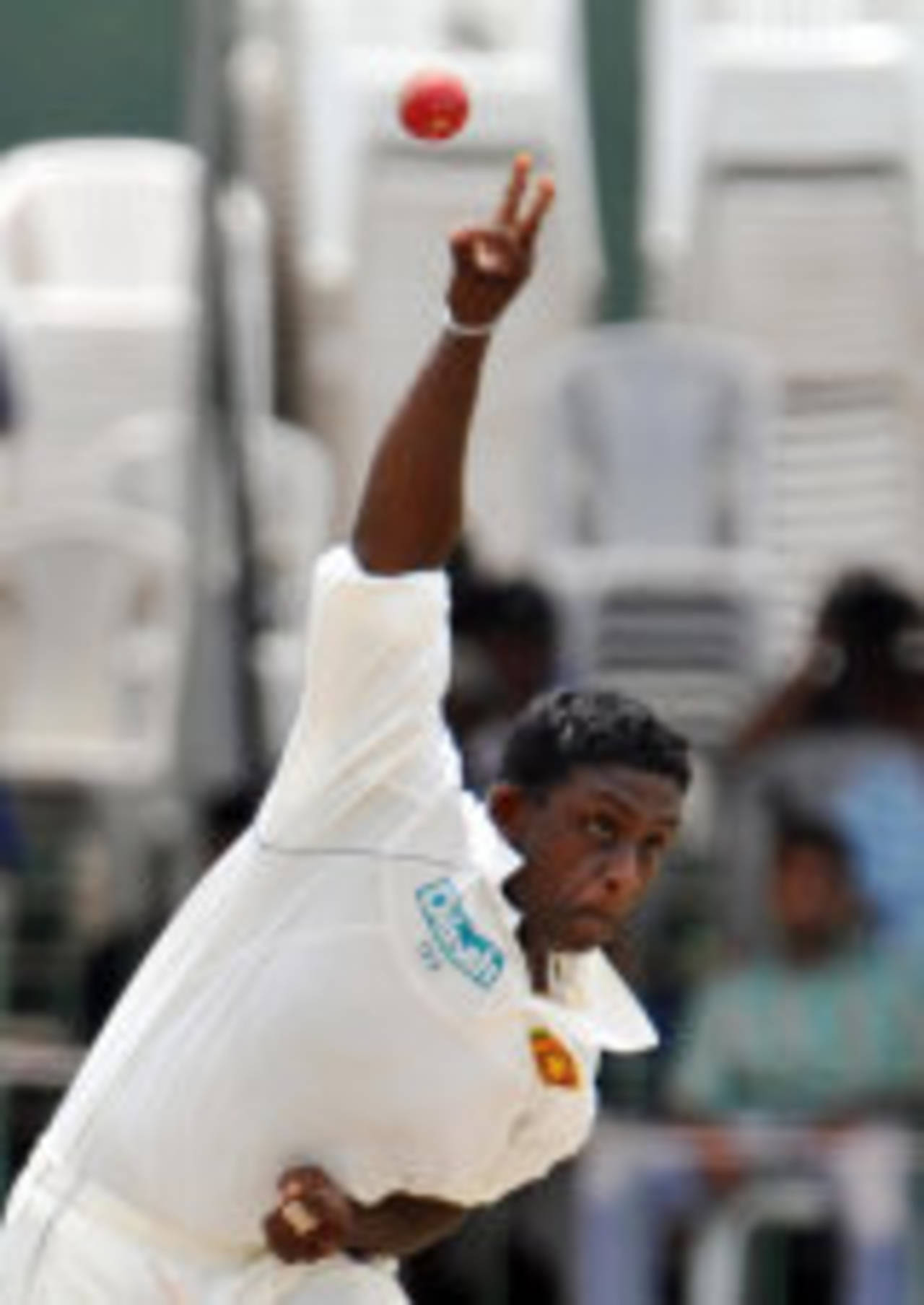The Serendip sensibility
Ashok Malik
25-Feb-2013

AFP
For an Indian cricket fan, the first Test match of the series in Sri Lanka was a humbling experience. The Indian cricket community and media not being given to patience, inevitably the attack will begin – on the captain, the poor spin bowling and the ageing middle order.
Frankly, that is an issue I don’t want to touch upon for the simple reason that one Test match is too little time in which to decide that entire careers are over and wholesale changes are needed. If the rest of the series proceeds like this, then perhaps there may be long-term issues to address. Even so, that is meat for another post, another time.
The point I want to focus on today is how Sri Lanka, for the past 20 odd years and certainly since the mid-1990s, remains the most underrated and under-appreciated top quality cricket team in the world. To an attack led by a fine fast bowler and one of the greatest spinners in history, they’ve added a lethal new weapon. Their cricket system has this enviable ability to churn out a series of elegant and/or devastatingly destructive batsmen, one after the other.
How do they do it? I’m no expert on Sri Lankan cricket and its infrastructure. I can only refer to what I’ve read and heard. One story never fails to make an impression. I read it years ago, shortly after the 1996 world cup was won by Arjuna Ranatunga’s men – by the blazing opening pair of Jayasuriya and Kaluwitharana – when Rohit Brijnath wrote a piece in India Today on Sri Lanka’s cricket nursery.
I can’t recall the entire article but do remember a reference to the integrity and honesty of the Sri Lankan cricket work ethic. I think it was in Brijnath’s article that I read about the Wettimuny brothers, Sunil, Mithra and Sidath (Sri Lanka’s first test centurion). reproducing a fraying, century-old English coaching manual, page by page, painstakingly drawing the illustrations, copying the text.
It was an age before ubiquitous photocopying machines and scanners, I suppose, and being classicists, the brothers felt the young cricketers in their charge must learn cricket the right way. The romantic in me would like to believe that some of the young men in the team that smashed India on July 26 were beneficiaries of the Wettimuny way.
It is an unusual anecdote but to my mind a memorable one. The Wettimuny brothers’ act was perhaps the most moving tribute an international cricketer had ever paid to his art form, a reverential prayer to “Mother Cricket”, to borrow an expression South African coach Mickey Arthur used recently, albeit in another context.
I wish I could rattle off names of Indian cricketers who would gladly do the same to pay their dues, pass on their skills to another, less endowed generation. For me, that sentiment, that sense of obligation sums up cricket more than statistics, razzmatazz and other trivia.

AFP
I’ve never seen a cricket match in Sri Lanka – though I do want to go there for a test some day – but have visited Colombo three times. I’ve discussed cricket with auto-rickshaw and taxi drivers, government officials, hotel waiters, bookstore managers, bartenders, you name it. The Sri Lankans love their cricket, are fiercely proud of their cricket team and badly want it to win.
Yet, it’s struck me that their pride and passion is never overdone or overaggressive. It’s not as if they’re trying to tell you that not only is the Sri Lankan team good but the Indian (and every other) team is bad or otherwise less than reputable. There is no deliberate running down of the other guy. Perhaps he exists, but I’ve never met the Ugly Sri Lankan Cricket Fan. I’ve encountered his equivalent in or from India, Pakistan and Australia more often than I’d want to.
To me, the best cricket tradition is one that plays the game hard, speaks in the contemporary idiom and yet salutes cricket’s glorious, unparalleled heritage. Among the three major Asian countries, I think Sri Lanka has it just right. Indian cricket swings wildly between (usually imagined) victimhood and overweening arrogance, including telling English county clubs whom to select or drop. Pakistan’s is another cricket establishment with just too many chips on its shoulder.
Sri Lanka is different. It fights and fights fiercely when it has to. Ranatunga was the prototype of the assertive, tough-as-nails Asian captain when he defended his star bowler – accused of chucking – through a gruelling tour of Australia. He took on the umpires, the other team, the unfriendly press – because he believed in his cause, his team, his country.
Even so, Sri Lankan cricket does not believe in a permanent war theory. The past is over; the mid-1990s are dead. The team and the country have moved on. The Indian and Pakistani cricket boards, on the other hand, are continually fighting yesterday’s wars.
If you’re ever in Colombo, visit the Cricket Café – at least that’s what I think it’s called. Among other things, it serves great sea food but that’s not the only reason I have fond memories of it. In its own manner, it’s a delightful little cricket museum, with memorabilia from, well, Old Blighty to New Ceylon. It has place for Hutton and Hobbs but, equally, for Murali and Mendis.
To me, this signified a small but important lesson. Sri Lankans love their cricket team and also love cricket. They don’t see the two emotions as either synonymous or mutually exclusive. I’ve never visited an Indian restaurant with a similar sensibility. Sure, I could go to one with posters of current Indian cricket stars – but would that be a celebration of cricket? There is a difference.
Sri Lankans, as a society, understand that difference. That’s why it’s impossible to grudge them victory, even when they’ve hammered your team.
Ashok Malik is a writer based in Delhi